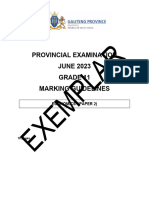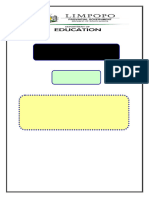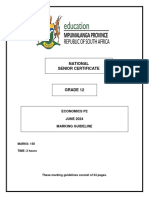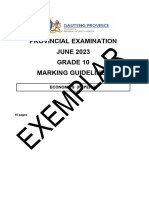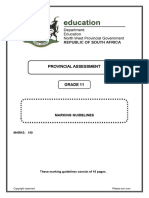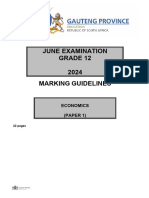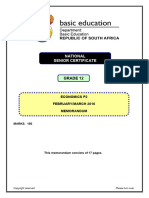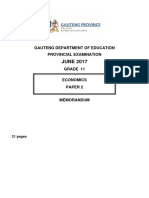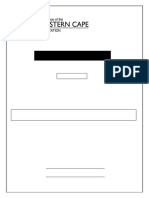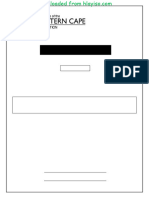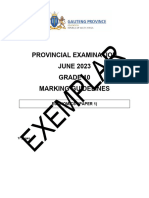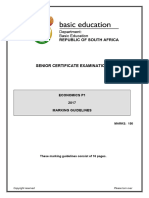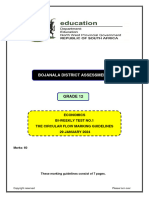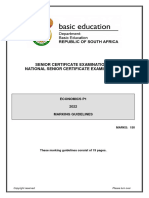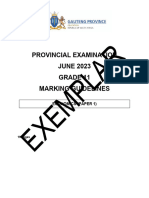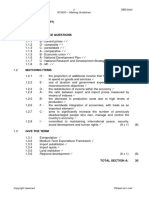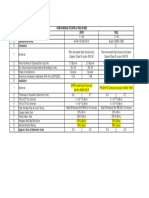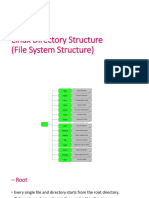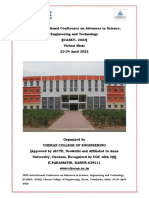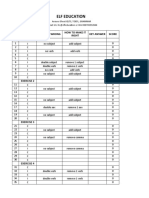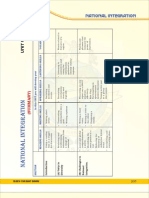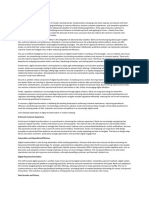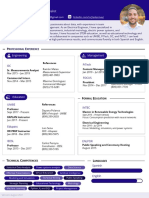NW NSC GR 11 ECONOMICS P2 ENG MEMO Nov 2019
NW NSC GR 11 ECONOMICS P2 ENG MEMO Nov 2019
Uploaded by
bhekiumuzi.dCopyright:
Available Formats
NW NSC GR 11 ECONOMICS P2 ENG MEMO Nov 2019
NW NSC GR 11 ECONOMICS P2 ENG MEMO Nov 2019
Uploaded by
bhekiumuzi.dOriginal Title
Copyright
Available Formats
Share this document
Did you find this document useful?
Is this content inappropriate?
Copyright:
Available Formats
NW NSC GR 11 ECONOMICS P2 ENG MEMO Nov 2019
NW NSC GR 11 ECONOMICS P2 ENG MEMO Nov 2019
Uploaded by
bhekiumuzi.dCopyright:
Available Formats
PROVINCIAL ASSESSMENT
GRADE 11
ECONOMICS P2
MARKING GUIDELINES
NOVEMBER 2019
MARKS: 150
These marking guidelines consist of 17 pages.
Copyright reserved Please turn over
Economics/P2 2 NW/November 2019
NSC – Grade 11 – Marking Guidelines
SECTION A (COMPULSORY)
QUESTION 1
1.1 MULTIPLE-CHOICE QUESTIONS
1.1.1 B (income elasticity)
1.1.2 C (ineffective allocation of resources)
1.1.3 A (variable costs divided by units produced)
1.1.4 B (complimentary)
1.1.5 D (IMF)
1.1.6 A (free movement of goods and service)
1.1.7 D (social grants)
1.1.8 B (ultraviolet rays) (8 x 2) (16)
1.2 MATCHING ITEMS
1.2.1 F (Able to influence the market price through changing the quantity
it supplies to the market.)
1.2.2 D (Barriers to enter the market)
1.2.3 G (making as much profit as possible)
1.2.4 E (Period long enough to change the input)
1.2.5 B (A low population density and much of the land is dedicated to
agriculture)
1.2.6 C (Appear when a country can produce more of a product than
another country using the same amount of resources)
1.2.7 H (Gas emissions and climate change)
1.2.8 I (people care for flora and fauna if they are given the rights to
own them) (8 x 1) (8)
1.3 GIVE ONE TERM
1.3.1 Cross elasticity
1.3.2 Relative price .
1.3.3 Monopolistic competition
1.3.4 Sustainability / Environmental sustainability
1.3.5 Import substitution
1.3.6 Urbanization (6 x 1) (6)
TOTAL SECTION A: 30
Copyright reserved Please turn over
Economics/P2 3 NW/November 2019
NSC – Grade 11 – Marking Guidelines
SECTION B
Answer TWO of the three questions in this section in the ANSWER BOOK.
QUESTION 2: MICROECONOMICS
2.1 Answer the following questions.
2.1.1 Name any TWO monopoly industries in South Africa.
Eskom/ Rand Water / any other relevant answer (2 x 1) (2)
2.1.2 How does scarcity impact on total utility?
One has to choose which goods and services to buy with their limited
resources in order to get maximum satisfaction. (1 x 2) (2)
2.2
2.2.1 How are monopolies protected?
By legislation
Barriers such as a patent (2)
2.2.2 Identify TWO of the three state monopolies implied in the extract
SAA
Eskom
Transnet (Any 2 x 1) (2)
2.2.3 Explain the role of a monopoly as a price maker
The monopolist is considered a price maker because it is able to influence
the market price by changing the quantity available to the market.
(Any other relevant answer) (2)
2.2.4 Why do you think South Africa should end the monopolies in the
above extract?
Underperformance: Tax fees are used to counteract these
underperformance of monopolies,
No substitutes: The consumer is left with no other choice as they are the
only suppliers of these specific services / products.
Limited competition: More competition will lead to more efficiency and
fairer prices.
Restricted access: Access to the market for alternative competition is
hampered.
(Any other relevant answer) (2 x 2) (4)
2.3
2.3.1 What does the abbreviation TVC stand for?
Total variable cost (1)
2.3.2 Why is the TFC curve horizontal?
Total Fixed Cost remains constant.
Total Fixed Cost is a fixed amount and not linked to production or output.
Copyright reserved Please turn over
Economics/P2 4 NW/November 2019
NSC – Grade 11 – Marking Guidelines
(Accept any other relevant correct answer.) (1)
2.3.3 Give the formula for total cost as seen in the graph above.
Total Cost = Fixed cost + Variable cost (2)
2.3.4 Explain the term short term in terms of fixed and variable inputs.
The short term is the production period during which only the
variable production factors can change while; fixed inputs remain
constant. The period is too short for fixed input to change
A period where some fixed production factors cannot change. (2)
2.3.5 What does the marginal cost of a business entail?
The increase in total cost when one additional unit of output is
produced
The change in total cost, resulting from a change in the quantity of output
produced by a firm
If you know the marginal cost of a product, you know how much it costs
to produce this additional unit.
Marginal cost must be calculated and together with marginal revenue it
determines profit maximisation point of the business.
(Accept any other relevant correct answer.) (2 x 2) (4)
2.4 Discuss non-price methods to increase market share.
To create loyalty to a brand name
To have longer shopping and business hours
To do business over the internet (banking and shopping)
To provide good after-sales services
To provide additional services (such as free travel insurance by banks)
To reward customers for loyalty
To offer door-to-door delivery (Any 4 x 2) (8)
2.5 What reasons would you provide for the reaction of consumers to
price changes?
The availability of substitutes - the greater the number of substitutes and the
closer the substitutes are to each other, the easier it is for households to start
using alternative goods.
The period in question - Households have time to adjust to price changes by
changing their behavior over the long term; the longer price increases continue,
the more consumers will adjust their demand for the product.
The degree of necessity or luxury of the product - Goods considered essential
by households tend to be more inelastic.
The proportion of income spent on the product - The smaller the proportion of
income spent on a product, the more price-inelastic the demand for the product
will be. (4 x 2) (8)
[40]
Copyright reserved Please turn over
Economics/P2 5 NW/November 2019
NSC – Grade 11 – Marking Guidelines
QUESTION 3: CONTEMPORARY ECONOMIC ISSUES
3.1 Answer the following questions.
3.1.1 Give TWO indicators used to measure poverty.
Purchasing-power parity (PPP)
Cost-of-basic needs method
Food-energy intake method
(Accept relevant answer.) (2x1) (2)
3.1.2 Why is it beneficial for a country to engage in free trade?
It promotes international trade and also promotes foreign direct
investment.
(Any other relevant answer) (1 x 2) (2)
3.2
3.2.1 Where does the government get the funds to pay social grants?
From tax revenue (1)
3.2.2 How does the payment of social grants affect the poor?
It increases their living standards / enables them to meet basic needs
(Any other relevant answer) (1)
3.2.3 Briefly describe the term absolute poverty.
Lack of basic human needs such as food, shelter and clean water.
(Any other relevant answer) (2)
3.2.4 Identify TWO attempts by the government to alleviate poverty in South
Africa.
The government has come up with the following strategies: RDP, GEAR,
ASGISA, New Growth Path.
Government could create job opportunities.
Government could provide social grants.
Government could skill and train people.
Government could fix prices of basic food.
Government could offer free services.
Access to basic services.
Employment generating programmes and income support.
Changing labour laws.
(Accept any other relevant correct answer.) (2)
Copyright reserved Please turn over
Economics/P2 6 NW/November 2019
NSC – Grade 11 – Marking Guidelines
3.2.5 Explain how inefficient policies can lead to poverty.
Poor government policy can exacerbate poverty instead of solving it.
Discrimination against certain ethnic groups may occur due to a certain
group being in power in government and this may increase poverty
levels of certain other groups in a country.
Sometimes a policy may have unintended consequences, e.g. land
reform may lead to land being given to incompetent farmers.
Corruption may also lead to bad government actions, where projects are
implemented, not on the basis of the good that they contribute to the
population, but on the basis of bribes. (2 x 2) (4)
3.3
3.3.1 Identify TWO environmental issues (problems) that can be derived
from the cartoon.
Climate change
Loss of biodiversity
Energy crisis
Over-utilization of natural resources
Land degradation
Overpopulation
Pollution
Waste Management (Any 2 x 1) (2)
3.3.2 Explain sustainable economic development.
Sustainable economic development is the development of an area using
techniques and approaches that will help to protect the environment for the
future. (2)
3.3.3 Name action steps that households can take to reduce the amount of
toxic material we use.
Households can retrieve cans, paper, plastic containers and bottles
Use more of lift clubs and public vehicles to reduce the number of
vehicles on the roads
Use solar power and water-saving appliances
Use non-toxic detergents
Use of proper dumping sites, specially allocated for dumping
Creating environmentally friendly gardens by planting indigenous, water-
saving plants, using organic waste compost and avoiding poisonous
insecticides and herbicides
(Any relevant answer) (Any 2 x 1) (2)
Copyright reserved Please turn over
Economics/P2 7 NW/November 2019
NSC – Grade 11 – Marking Guidelines
3.3.4 What could the government do to prevent the unsustainable use of the
environment?
Appropriate government policy can increase the protection of the
environment.
Remove dangerous additives from petrol, such as lead.
Encourage the use of environmentally friendly energy sources such as
wind, wave and solar power, as opposed to power generated by fossil
fuels.
Ensure that all new buildings are energy efficient.
Implement regulations to reduce pollution, such as the successful policy
to reduce the use of plastic shopping bags.
(Accept any other relevant correct answer.) (2 x 2) (4)
3.4 Tabulate TWO differences to illustrate the North-South divide.
NORTH SOUTH
Highly developed infrastructure Weak infrastructure
High levels of production and Low levels of production and
consumption consumption
Industrialised countries Non-industrialised
Average incomes are very high Average incomes are low
MAX: 4 MARKS MAX: 4 MARKS
3.5 How do unequal income levels and education shortages contribute to
poverty?
Unequal income levels
The wages and salaries earned for various jobs are not the same.
There are high paying jobs in the financial and technological sectors. Workers
in the low-paying jobs will not be able to satisfy their basic needs.
(2 x 2)
Lack of education
Many poor countries are unable to fund education.
This leads to a large percentage of the population being uneducated and
lacking in skills that are needed in the workplace.
Lack of educational qualifications usually leads to lower productivity, lower
income levels and lower employment. (2 x 2)
(2 x 4) (8)
QUESTION 4: MICROECONOMICS AND CONTEMPOTRARY ECONOMIC
ISSUES
4.1 Answer the following questions.
4.1.1 List any TWO types of pollution.
Land pollution
Air pollution
Water pollution
Noise pollution (Any 2 x 1) (2)
Copyright reserved Please turn over
Economics/P2 8 NW/November 2019
NSC – Grade 11 – Marking Guidelines
4.1.2 What effect does a price elastic demand have on a producer?
It tells the producer that, should the price of a product increase:
The quantity demanded decreases leading to a decrease in total
revenue.
It will be easy for the consumer to substitute the expensive product for
the cheaper product and the producer will lose customers.
(Accept the opposite, that is, the effect of decrease in price.)
(1 x 2) (2)
4.2
4.2.1 Identify the phenomenon depicted by the cartoon.
Price elasticity of demand / inelastic demand (1)
4.2.2 Name ONE example of normal goods.
Any product that is competitive in consumption and exclusive eg. Medical
Services (Any other relevant example) (1)
4.2.3 Explain perfectly inelastic demand.
Perfect inelastic demand has an elasticity coefficient of zero and is
depicted by a vertical line.
It indicates that a change in the price has no effect on the quantity
demanded. (2)
4.2.4 A product has a price elasticity of 1.58. What kind of elasticity
of demand does it represent? Motivate your answer.
Price elastic demand (Price elasticity <1)
The amount demanded by the consumer reacts strongly to a price change
/ the percentage change in quantity demanded is greater than the
percentage change in price. (2)
4.2.5 Why is the elasticity of demand important to producers?
Tells a producer that for every action there is a reaction.
By studying price elasticity of demand, we can predict what the change
in price will be for the producers.
Price elasticity of demand is useful to help firms decide how to increase
their total revenue.
To increase its total revenue the producer can (1) raise the price to get
more revenue per product; and (2) drop the price to increase the
quantity sold.
If the buyers are sensitive to the price (elastic demand), they will buy
more if the price drops, so the producers should drop the
price.
If the buyers are not sensitive to price (inelastic demand) they will not
buy much less even if the price goes up, so the producers should
increase the price.
To increase sales, raise the price when the demand is inelastic, or
drop the price when the demand is elastic.
Producers want to know how sensitive the market supply is to a change
in the price of the product. (2 x 2) (4)
Copyright reserved Please turn over
Economics/P2 9 NW/November 2019
NSC – Grade 11 – Marking Guidelines
4.3
4.3.1 Name ONE main function of the World Trade Organization (WHO).
Promote free trade
Provide the benefits of economic development for all countries
Negotiate lower rates
Clear trading disputes (Any 1)
4.3.2 Why is the USA seen as a first-world country?
Because the USA :
Is economically better developed
residents have a higher life expectancy
has an effective and functional education and health system
has a highly developed infrastructure.
have high production and consumer levels.
is an industrialized country is
average income is very high.
(Any relevant answer) (Any 1)
4.3.3 Briefly explain the concept free trade.
It is the removal or reduction of trade tariffs such as import quotas and
import duties (2)
4.3.4 Explain the relationship between comparative advantage and free
trade.
Free trade results in specialisation: a country will concentrate on products
which can be produced at the least cost, compared to other countries.
(Accept any other correct relevant response) (2)
4.3.5 What do countries stand to gain from a free trade policy?
Increase access to higher quality and low-priced goods
Increase in economic growth
Improves efficiency and innovation
Promotes competition and fairness
(Accept any other correct relevant response) (Any 2 x 2) (4)
Copyright reserved Please turn over
Economics/P2 10 NW/November 2019
NSC – Grade 11 – Marking Guidelines
4.4 With the aid of a graph, explain the relationship between an increase in
consumption, total utility and marginal utility
Max
.4
Graphical explanation
As the units consumed increases, total utility increases at a lower rate
while marginal utility decreases at a faster rate
The total utility curve slopes upwards as the marginal utility curve slopes
downwards.
As consumption continues to unit 5, marginal utility becomes negative while
total utility declines.
(Accept any relevant correct explanation.) Max. 4 (8)
4.5 In which way do international agreements protect the environment?
The World Summit on Sustainable Development 2002
Held in Sandton, Johannesburg in 2002
Discussed challenges like improving people’s lives and conserving natural
resources in a world with an ever-growing populationand ever-increasing
demand for food, water, shelter, sanitation, energy, health services and
economic security.
Specific achievements:
o Biodiversity and conservation became important issues to reduce the rate of
species extinction.
o Access to sources of energy and water for the poor have been increased.
o Lead has been removed from petrol.
(Any relevant answer)
Copyright reserved Please turn over
Economics/P2 11 NW/November 2019
NSC – Grade 11 – Marking Guidelines
The Kyoto Protocol
The Kyoto Protocol was negotiated in 1997 and signed in 2005.
The treaty was signed by 170 countries. The USA has the world’s highest
emissions of carbon dioxide and has not signed the Kyoto Protocol.
The Protocol determined legal binding targets for cutting greenhouse gas
emissions.
(Accept any other relevant correct answer.)
The Millennium Development Goals
The MDGs are eight international development goals to all 193 United Nations
member states.
Goal 1: Eradication of extreme poverty and hunger
Goal 2: Achieve universal primary education.
Goal 3: Promote gender equality and empower women.
Goal 4: Reduce child mortality rates.
Goal 5: Improve maternal health.
Goal 6: Combat HIV/AIDS, malaria and other diseases.
Goal 7: Ensure environmental sustainability.
Goal 8: Develop a global partnership for development.
Concerns over environmental sustainability, has the following aims:
o Integrating the principles of sustainable development into countries’ policies
and programmes to reverse loss of environmental resources.
o Reducing the rate of biodiversity loss significantly by 2010
o Reducing by half the proportion of people without sustainable access to safe
drinking water and basic sanitation
o Achieving significant improvements in the lives of at least 100 million slum
dwellers by 2020
(Any relevant answer)
COP 17 conference, Durban 2011
Cop 17 was the 17th Conference of the Parties to the Kyoto Protocol on climate
change.
COP 17 established a Green Climate Fund to help developing countries to
establish cleaner sources of energy and to adapt to climate change.
It is hoped that countries will contribute to the fund so that it can start operating
in 2012.
(Accept any other relevant correct answer.) (Any 2 x 4) (8)
[40]
Copyright reserved Please turn over
Economics/P2 12 NW/November 2019
NSC – Grade 11 – Marking Guidelines
SECTION C
Answer any ONE of the two questions in this section in the ANSWER BOOK.
MARK
STRUCTURE OF ESSAY
ALLOCATION
Introduction
The introduction is a lower order response: Max. 2
A good starting point would be to define the main concept related
to the question topic
Do not include any part of the question in your introduction
Do not repeat any part of the introduction in the body
Avoid saying in the introduction what you are going to discuss in
the body
Body
Main part: Discuss in detail/In-depth discussion/Examine/Critically Max. 26
discuss/Analyse/Compare/Evaluate/Distinguish/Differentiate/Explain
Additional part: Give own opinion/Critically discuss / Evaluate / Max. 10
Critically evaluate/Draw a graph and explain / Use the graph given
and explain / Complete the given graph / Calculate / Deduce /
Compare/Explain/ Distinguish/Interpret/Briefly debate/ How/ Suggest
Conclusion
Any higher-order conclusion should include: Max. 2
A brief summary of what has been discussed without repeating
facts already mentioned
Any opinion or value judgement on the facts discussed
Additional support information to strengthen the
discussion/analysis
A contradictory viewpoint with motivation, if required
Recommendations
TOTAL NUMBER OF MARKS 40
QUESTION 5: MICROECONOMICS 40 MARKS
Explain substitute and complementary products fully using graphs. (26)
What is the relationship between the product market and the factor market?
(10)
[40]
INTRODUCTION
A demand relationship occurs when two or more goods and services are demanded at the
same time, due to the fact that they can be used together.
(Accept any relevant introduction.) (2)
Copyright reserved Please turn over
Economics/P2 13 NW/November 2019
NSC – Grade 11 – Marking Guidelines
BODY
There are two types of demand relationships i.e. substitutes and complements.
Substitutes
A substitute product is a product that is used in place of another product.
Some products have specific relationships that will affect demand.
Example: if you want to buy beef but it is too expensive, you tend to buy a cheaper
alternative, e.g. chicken. In this instance, chicken is the substitute product.
EXPLANATION OF THE GRAPH
Price of beef
The price of beef increases from P to P1 due to a decrease in supply (supply curve
shifts from SS to S1S1).
Beef leads to a decrease in quantity demanded of beef from Q to Q1.
Demand for chicken
The demand for the substitute good, which is chicken, increases from DD to D1D1.
Because of the increase in demand price also increases from P to P1.
This implies that an increase in price of one product will cause an increase in demand of
substitute products. Max. 13
Complements
Products are complementary products when they are used together to satisfy a need or a
want e.g. tea and milk.
Copyright reserved Please turn over
Economics/P2 14 NW/November 2019
NSC – Grade 11 – Marking Guidelines
EXPLANATION OF THE GRAPH
Price of tea
The price of tea increases due to a decrease in supply.
Supply curve shifts from SS to S1S1.
The price of tea increases from P to P1.
Quantity demanded for tea decreases from Q to Q1.
The demand for milk
The increase in price of tea will cause a decrease in demand for milk.
People will buy less tea, therefore they will need less milk.
This causes the demand curve (DD) to shift leftwards to D1D1, and quantity
demanded decreases from Q to Q1 and price will decrease from P to P1.
For complementary goods, when the price of one good increases, the demand for the
complementary product will decrease. If the price of one product decreases, the demand
for complement products will increase. (Max. 13)
(26)
Copyright reserved Please turn over
Economics/P2 15 NW/November 2019
NSC – Grade 11 – Marking Guidelines
ADDITIONAL PART
The factor market is a market where factors of production are bought and
sold.
The product market is a market where goods and services are bought and
sold.
The product market depends on the factor market for the availability of factors of
production.
When the supply of one factor of production changes, it will affect both the factor
market and the product market
A change in supply of skin hide would affect the hide market negatively because there
would be a decrease in the supply of hide.
That would also affect shoe manufacturing and there would be fewer shoes and bags
available in the product market for shoes and bags
When the demand for shoes in the product market increases, the demand for factors
of production in the factor market will also increase. (10)
CONCLUSION
It is important that product and factor markets work closely with one another and
understand each other, because they are interdependent; one cannot exist without the
other.
(Accept any correct relevant conclusion.) (2)
[40]
QUESTION 6: CONTEMPORARY ECONOMIC ISSUES 40 MARKS
Discuss the causes of poverty in detail. (26)
Is the South African government successful in their efforts to alleviate poverty?
(10)
[40]
INTRODUCTION
Poverty is when people are unable to satisfy their basic need and their standard of living
is low.
(Accept any other correct relevant introduction) (2)
BODY
Unemployment:
Without a decent income people cannot fulfil their basic needs. Poor people depend
heavily on subsistence farming for a living.
Insufficient infrastructure:
Large size of rural areas and their uneven distribution, make it expensive to provide
sufficient infrastructure; this is a major cause of poverty in South Africa.
The following needs to be improved: transport systems and information technology
necessary for doing business, clean water and sanitation, energy and urban
developments
Copyright reserved Please turn over
Economics/P2 16 NW/November 2019
NSC – Grade 11 – Marking Guidelines
Poor health conditions:
Diseases decrease the amount of work that weak or ill people will do, this reduces their
income, driving them deeper into poverty.
Diseases such as HIV and Aids can cause death and cut off a main source of income for
the family.
High medical costs which many poor families cannot afford
Lack of education:
This keeps people from obtaining decent jobs that would lift them and their families out of
poverty.
A lack of education increases the gap between the skills needs of the economy and the
supply of those needs.
High population growth:
Large numbers of people with too few resources, too few jobs and not enough food are
basic causes of poverty,
Over-population leads to the deterioration of the natural environment, including water
sources, soil, and forests.
Welfare dependency:
Social grants may act as deterrent to people working or looking for employment.
Some people prefer to live on grants which meet their basic needs, and so remain in
situation of poverty.
Dysfunctional government:
Many developing countries have created their own misfortune because they are often
unstable and corrupt.
They do not always respect and honour budget, procedures and protocols.
Weak democracy distorts how resources are allocated; this leads to services not being
delivered, people not receiving their basic needs.
War and Conflict:
A large portion of today’s global poverty is found in war-torn and post-conflict countries.
Money is often wasted on weapons. Education gets disrupted, which causes further
poverty
Lack of productive resources:
In poor countries there are not enough productive resources to ensure sustainable
livelihoods
Human capital is low due to hunger, disease and low literacy levels.
Natural resources decline, because trees are cut down and soil is exhausted.
Capital is needed for future investments, but a lack of savings makes this impossible.
Poor rural villages need paved roads, power generators, irrigation channels, trucks, etc.
Entrepreneurship is non-existent, because of a lack of education and skills development
Copyright reserved Please turn over
Economics/P2 17 NW/November 2019
NSC – Grade 11 – Marking Guidelines
Global financial crisis:
Poor countries do not have money for investments, which are important for development
and growth.
Economic growth has not been shared fairly and the economic crisis further widens the
gap between rich and poor.
Rising food prices partly form new biofuel policies, means hunger for many and worsens
global poverty
Urbanisation and forced resettlements:
Migration within a country often leads to poverty.
Sometimes people living in rural areas choose to move to cities, because they see little
potential to generate an income in the rural areas far away from markets Sometimes
people are forced to move to make way for development schemes.
In both cases, people often end up living in informal settlements on the fringes of cities.
(8 marks for mere listings and examples) (26)
ADDITIONAL PART
Has South Africa been successful in trying to deal with this challenging issue of
poverty?
The government has been successful in the following ways:
The number of social grant beneficiaries has increased drastically
The government has tried to build many schools to reduce the level of illiteracy
The newly devised national development plan, with its aim of eliminating poverty and
reducing inequality by 2030
Access to water and formal housing has risen from 63,5% to 79,8%
Most people have access to electricity
The government has also introduced ‘no fee’ schools, nutrition and also transport to
and from schools
Negatives:
Poor health and unemployment are still an issue
The country needs more employment creation, e.g. SMME’s Emphasis should be on
good leadership (10)
CONCLUSION
The South African government has tried to reduce poverty although a lot more still needs
to be done.
(Accept any relevant conclusion) (2)
[40]
TOTAL SECTION C: 40
GRAND TOTAL: 150
Copyright reserved Please turn over
You might also like
- STANISZEWSKI, Mary Anne - 1995 - Believing Is Seeing - Creating The Culture of Art PDFDocument324 pagesSTANISZEWSKI, Mary Anne - 1995 - Believing Is Seeing - Creating The Culture of Art PDFjhonNo ratings yet
- FM-087 Plant Pre Acceptance Checklist - APS042 Skid SteerDocument2 pagesFM-087 Plant Pre Acceptance Checklist - APS042 Skid SteerWenceslao JaimesNo ratings yet
- Pathways to Low-Carbon Development for the PhilippinesFrom EverandPathways to Low-Carbon Development for the PhilippinesNo ratings yet
- Economics P1 May-June 2021 MG EngDocument19 pagesEconomics P1 May-June 2021 MG EngTshegofatso JacksonNo ratings yet
- Economics P2 Nov 2021 MG EngDocument21 pagesEconomics P2 Nov 2021 MG Engmakoelulu3No ratings yet
- Economics P2 Feb-March 2018 Memo EngDocument16 pagesEconomics P2 Feb-March 2018 Memo EngKhanyisile KhanyiNo ratings yet
- economics p2 nov 2022 memoDocument23 pageseconomics p2 nov 2022 memoneliswanonhlanzeko217No ratings yet
- GR 11 Eco P2 (English) June 2023 Possible AnswersDocument18 pagesGR 11 Eco P2 (English) June 2023 Possible Answersolu2687No ratings yet
- Economics P2 Nov 2020 Memo EngDocument20 pagesEconomics P2 Nov 2020 Memo EngrorisangvlonebouyNo ratings yet
- Gr11 ECN P2 June 2018 Possible AnswersDocument21 pagesGr11 ECN P2 June 2018 Possible Answers5gd2ywxc4dNo ratings yet
- NW NSC Economics P2 MG Eng Sept 2024Document19 pagesNW NSC Economics P2 MG Eng Sept 2024PanasheNo ratings yet
- Economics P2 May-June 2021 MG EngDocument18 pagesEconomics P2 May-June 2021 MG EngTshegofatso JacksonNo ratings yet
- Economics GR 10 MEMO Paper 2Document8 pagesEconomics GR 10 MEMO Paper 2Samukelisiwe SamkeNo ratings yet
- Economics P2 Memo 202409Document18 pagesEconomics P2 Memo 202409lungilegosiame64No ratings yet
- Economics P2 MGDocument24 pagesEconomics P2 MGmathelerato483No ratings yet
- Grade 12 NSC Economics P2 (English) September 2022 Preparatory Examination Possible AnswersDocument19 pagesGrade 12 NSC Economics P2 (English) September 2022 Preparatory Examination Possible Answersbokamoshomatlhare92No ratings yet
- GR 10 ECO P2 (English) June 2023 Possible AnswersDocument16 pagesGR 10 ECO P2 (English) June 2023 Possible Answerssangaraclethia75No ratings yet
- Economics P2 May-June 2022 MG EngDocument19 pagesEconomics P2 May-June 2022 MG EngmpiloelishNo ratings yet
- GR 11 Economics P2 Memo EngDocument25 pagesGR 11 Economics P2 Memo Engnomathembalinda001No ratings yet
- ECONOMICS P2 GR12 MEMO JUNE2022 - EnglishDocument17 pagesECONOMICS P2 GR12 MEMO JUNE2022 - Englishtshiditladi93No ratings yet
- Economics p1 Gr11 Memo Nov2022 - EnglishDocument17 pagesEconomics p1 Gr11 Memo Nov2022 - EnglishritotruthNo ratings yet
- ECONOMIC P2 GR11 MEMO NOV2023 - EnglishDocument21 pagesECONOMIC P2 GR11 MEMO NOV2023 - EnglishntellymathebelaNo ratings yet
- Economics P2 Memo June 2022 Eng Eastern CapeDocument18 pagesEconomics P2 Memo June 2022 Eng Eastern Capekuhlulakuhlula541No ratings yet
- KZN Economics Grade 11 June 2023 P2 and Memo - 240605 - 091427Document28 pagesKZN Economics Grade 11 June 2023 P2 and Memo - 240605 - 091427maruthamichellegwen13No ratings yet
- MP Economics Grade 12 September 2023 P2 and MemoDocument32 pagesMP Economics Grade 12 September 2023 P2 and Memomndebele.angel02No ratings yet
- Economics Grade 12 Supp June 2021 P1 and MemoDocument31 pagesEconomics Grade 12 Supp June 2021 P1 and Memotshiditladi93No ratings yet
- ECONOMICS P2 GR12 MEMO SEPT 2023 EnglishDocument20 pagesECONOMICS P2 GR12 MEMO SEPT 2023 EnglishLwandè ShabalalàNo ratings yet
- Economics p1 Nov 2022 Memo Eastern CapeDocument18 pagesEconomics p1 Nov 2022 Memo Eastern Capebohlale.mosalaNo ratings yet
- 11 June s2 NW 11 Economics p2 MG Eng June 2024Document16 pages11 June s2 NW 11 Economics p2 MG Eng June 2024davidrafedile12No ratings yet
- Economics p1 Gr11 Memo Nov2022 - English-1Document17 pagesEconomics p1 Gr11 Memo Nov2022 - English-1Laddiey SneNo ratings yet
- Economics p2 Memo Gr10 Nov 2017 Eng Final AutosavedDocument15 pagesEconomics p2 Memo Gr10 Nov 2017 Eng Final Autosavedngwenyamichelle2009No ratings yet
- LP Economics Grade 11 September 2024 P2 and MemoDocument31 pagesLP Economics Grade 11 September 2024 P2 and MemonataliextashieyxNo ratings yet
- Economics p1 Gr11 Memo Nov2022 - EnglishDocument17 pagesEconomics p1 Gr11 Memo Nov2022 - Englishjmtshali031No ratings yet
- Official GR 12 Economics P1 Eng MemoDocument26 pagesOfficial GR 12 Economics P1 Eng Memoshakokasongo7No ratings yet
- ECONOMICS P2 MEMO GR12 JUNE 2023 - EnglishDocument20 pagesECONOMICS P2 MEMO GR12 JUNE 2023 - Englishtshiditladi93No ratings yet
- .archECONOMICS P1 GR12 MEMO SEPT 2024 - EnglishDocument22 pages.archECONOMICS P1 GR12 MEMO SEPT 2024 - EnglishHamid RabiuNo ratings yet
- Economics P2 Feb-March 2016 Memo EngDocument17 pagesEconomics P2 Feb-March 2016 Memo Engtshayingwembasa4No ratings yet
- GR 11 Economics P2 Eng MEMODocument21 pagesGR 11 Economics P2 Eng MEMOMichael EbenezerNo ratings yet
- P2 June MGDocument19 pagesP2 June MGnomvulamathipaNo ratings yet
- Economics p2 Gr11 Memo Nov2022 - EnglishDocument19 pagesEconomics p2 Gr11 Memo Nov2022 - Englishnakediramusi23No ratings yet
- Economics NSC P1 Memo Nov 2022 EngDocument22 pagesEconomics NSC P1 Memo Nov 2022 Engxhanti classenNo ratings yet
- Economics P1 Nov 2022 MG EngDocument21 pagesEconomics P1 Nov 2022 MG Engnontokozoangel562No ratings yet
- Economics p1 Memo Gr10 Nov2017Document15 pagesEconomics p1 Memo Gr10 Nov2017ngwenyamichelle2009No ratings yet
- Economics NSC P2 MEMO May June 2023 Eng Eastern CapeDocument21 pagesEconomics NSC P2 MEMO May June 2023 Eng Eastern Capepalesamasakala641No ratings yet
- Econ p1 Gr11 Memo Nov 2020Document15 pagesEcon p1 Gr11 Memo Nov 2020usandagee15No ratings yet
- Circular Flow MemoDocument15 pagesCircular Flow MemoRoelien BekkerNo ratings yet
- Economics P1 Feb-March 2017 Memo EngDocument17 pagesEconomics P1 Feb-March 2017 Memo Engrossouw.jamieNo ratings yet
- Economics GR 11 MEMO Paper 1Document13 pagesEconomics GR 11 MEMO Paper 1faithamu984No ratings yet
- Economics GR 11 MEMO Paper 2 1Document10 pagesEconomics GR 11 MEMO Paper 2 1siphokazimahlangu240No ratings yet
- Official 10732 Economics P2 MemoDocument25 pagesOfficial 10732 Economics P2 Memomdugift429No ratings yet
- GR 10 ECO P1 (English) June 2023 Possible AnswersDocument17 pagesGR 10 ECO P1 (English) June 2023 Possible Answerssangaraclethia75No ratings yet
- Economics P1 May-June 2023 MG EngDocument22 pagesEconomics P1 May-June 2023 MG Engrossouw.jamieNo ratings yet
- Economics P1 May-June 2017 Memo EngDocument16 pagesEconomics P1 May-June 2017 Memo Engmahleangel39No ratings yet
- M.gs District Test On The Circular Flow Model-1Document5 pagesM.gs District Test On The Circular Flow Model-1Roelien BekkerNo ratings yet
- Economics p2 Gr11 Memo Nov2022 - EnglishDocument19 pagesEconomics p2 Gr11 Memo Nov2022 - Englishjmtshali031No ratings yet
- Economics P1 May-June 2022 MG EngDocument19 pagesEconomics P1 May-June 2022 MG Engntethelelontanzi9No ratings yet
- 07 June s2 NW 12 Economics p2 MG Eng June 2024Document20 pages07 June s2 NW 12 Economics p2 MG Eng June 2024itumelengthipe87No ratings yet
- Economics GR 11 MEMO Paper 2Document13 pagesEconomics GR 11 MEMO Paper 2amber45ngewuNo ratings yet
- Economic p2 Gr11 QP Memo Nov2020 Eng DDocument40 pagesEconomic p2 Gr11 QP Memo Nov2020 Eng Dmatjilalettah48No ratings yet
- Grade 11 Provincial Examination Economics P1 (English) June 2023 Possible Answers PDFDocument22 pagesGrade 11 Provincial Examination Economics P1 (English) June 2023 Possible Answers PDFntokozomanzini164No ratings yet
- Economics P1 May-June 2023 MG EngDocument16 pagesEconomics P1 May-June 2023 MG EngFrederikNo ratings yet
- India:: Sweat of The Brow: An Approach in Contrast To Minimum CreativityDocument3 pagesIndia:: Sweat of The Brow: An Approach in Contrast To Minimum CreativityAanika AeryNo ratings yet
- Admission Fee Receipt 20230454958Document1 pageAdmission Fee Receipt 20230454958akashypoNo ratings yet
- Editor's Desk: The Wellness Movement: Ideas For Improving Health OutcomesDocument13 pagesEditor's Desk: The Wellness Movement: Ideas For Improving Health OutcomesLázaro Alejandro Moynelo DíazNo ratings yet
- A277852-Rock Testing Handbook-Us ArmyDocument947 pagesA277852-Rock Testing Handbook-Us Armyekaamf100% (5)
- D1 Algorithms - SortingDocument19 pagesD1 Algorithms - Sortingtongshuo066No ratings yet
- Mazda 6 2003-2007 Transaxle Workshop Manual A65M-RDocument68 pagesMazda 6 2003-2007 Transaxle Workshop Manual A65M-RMariusFerdy0% (1)
- Comparison of CablesDocument1 pageComparison of CablesBajibabu ProdduturiNo ratings yet
- Lucci Connect Gecko Led 65mm RGB Decklight in BlackDocument1 pageLucci Connect Gecko Led 65mm RGB Decklight in BlackdjniyazidemiroskiNo ratings yet
- ME Math Champs DayDocument3 pagesME Math Champs Dayadele daguno100% (1)
- Language Revision GR 11Document8 pagesLanguage Revision GR 11Moagi LekakaNo ratings yet
- Achievers Adda - How To Justify A GAP in IBPS InterviewDocument4 pagesAchievers Adda - How To Justify A GAP in IBPS InterviewRamesh KumarNo ratings yet
- Linux Directory Structure (File System Structure)Document87 pagesLinux Directory Structure (File System Structure)breaperNo ratings yet
- Mindmatters, A Whole-School Approach Promoting Mental Health and WellbeingDocument8 pagesMindmatters, A Whole-School Approach Promoting Mental Health and WellbeingMohamed Amine ChenguitiNo ratings yet
- ICASET2022 BroucherDocument16 pagesICASET2022 BroucherjollyggNo ratings yet
- High Volume LS Series Engine Oil Pump Kit: Parts List # DescriptionDocument2 pagesHigh Volume LS Series Engine Oil Pump Kit: Parts List # DescriptionIgor MitrovićNo ratings yet
- 5 Receiving and Checking MoneyDocument25 pages5 Receiving and Checking MoneyLucio Indiana WalazaNo ratings yet
- Answer Sheet Exercise 1-5Document2 pagesAnswer Sheet Exercise 1-5Dhea ShabrinaNo ratings yet
- Unit 6 Main Course BookDocument61 pagesUnit 6 Main Course Bookvivekkkkkkk0% (1)
- Modern Banking TrendsDocument10 pagesModern Banking Trendsshramandas8No ratings yet
- Para-Cosymplectic ManifoldsDocument21 pagesPara-Cosymplectic ManifoldsanilNo ratings yet
- Biomass Pellet Firning Final - 2Document38 pagesBiomass Pellet Firning Final - 2amiyamech047858No ratings yet
- Directions For The User: Northern Mindanao Colleges, IncDocument7 pagesDirections For The User: Northern Mindanao Colleges, IncBrian Reyes GangcaNo ratings yet
- CV Jorge Ledesma (Eng) - Ago 2021Document2 pagesCV Jorge Ledesma (Eng) - Ago 2021Jorge Luis Ledesma UreñaNo ratings yet
- 2017 Set 2 IitrDocument24 pages2017 Set 2 IitrP Praveen KumarNo ratings yet
- Cohabitation Before Marriage As A Risk For DivorceDocument4 pagesCohabitation Before Marriage As A Risk For Divorce17 ENo ratings yet
- Moments, Levers and Gears 1 QPDocument21 pagesMoments, Levers and Gears 1 QPWisdom PhanganNo ratings yet
- Turk, Austin T. - The Criminalization ProcessDocument9 pagesTurk, Austin T. - The Criminalization ProcessKIAN HEMENTERANo ratings yet
- Task 2 - My Wonderful DreamsDocument4 pagesTask 2 - My Wonderful DreamsKary Julieth Estrada Perales100% (2)







